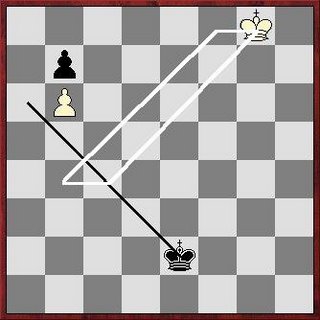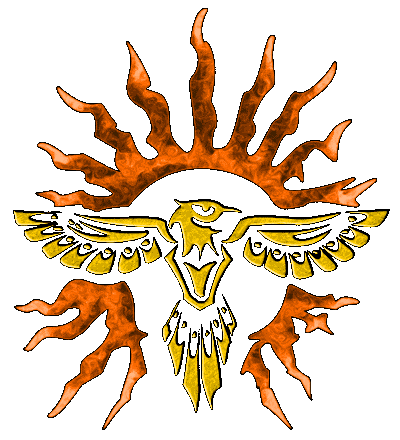Meeting hall
There is an easy way to calculate the relative positions of both kings when they approach each other.
The mathematical formula is straight forward
(king position 1) - (king position 2) - 2 = distance expressed as total amount of moves both kings can make, leading each other into the meeting hall.
Example
King 1 (white) on g8
King 2 (black) on e2
Diagram "White to play"

It takes White 5 moves to reach the opposition square b4. It also takes 5 moves to capture the pawn. Black needs 4 moves to defend his pawn and win the pawn of white. His target square is a6. If white wants to defend his pawn by going to c7 he will be the rabbit king in the turtle position. Whoever moves first looses.
The territory of the shortest path can easily be drawn if you know what the target squares are for both kings. Meaning the destination squares that you want your king to go to.
Black a6 - white b4 his best try to obtain a draw.
So white has two main diagonals (a2-g8;a3-f8) while black has one diagonal to reach his destination square. (straight line)
As both path crosses each other you would like to know where they meet, if there is impedement, and which King will be pushed off his path. This happens of course in the lovely place which we call "the meeting hall".

The meeting hall(green)is the square defined where possible impedement (shouldering effect) can take place. This means that the kings have come so near to each other that one of the kings have to prolong his path to his target square.
King pos 1 = g8 (8 rank)
King pos 2 = e2 (2 rank)
Formula: 8-2-2= 4 moves.
White begins, so he will have 2 moves played. Black will have 2 moves played. It will be White's turn to move.
From this knowledge you can draw easily the meeting hall and see what the relative position will be of both kings. Who has the move and who has not.
Rule: If both kings encounter each other in the meeting hall, impedement will only follow if one king succeeds in forcing the other king from his shortest path without leaving his shortest path. If the king has to step out of the territory formed by the shortest path, his path will be prolonged and he will need extra moves to reach his destination square.
So basically it comes down to 2 aspects (when the paths of the kings cross each other or come very near to each.)
What is the relative position of both kings in the meeting hall?
Can the king follow his traject without being hindered, bearing in mind the king who has the move? If he is not hindered he can reach his destination square without prolonging his path.
The mathematical formula is straight forward
(king position 1) - (king position 2) - 2 = distance expressed as total amount of moves both kings can make, leading each other into the meeting hall.
Example
King 1 (white) on g8
King 2 (black) on e2
Diagram "White to play"

It takes White 5 moves to reach the opposition square b4. It also takes 5 moves to capture the pawn. Black needs 4 moves to defend his pawn and win the pawn of white. His target square is a6. If white wants to defend his pawn by going to c7 he will be the rabbit king in the turtle position. Whoever moves first looses.
The territory of the shortest path can easily be drawn if you know what the target squares are for both kings. Meaning the destination squares that you want your king to go to.
Black a6 - white b4 his best try to obtain a draw.
So white has two main diagonals (a2-g8;a3-f8) while black has one diagonal to reach his destination square. (straight line)
As both path crosses each other you would like to know where they meet, if there is impedement, and which King will be pushed off his path. This happens of course in the lovely place which we call "the meeting hall".

The meeting hall(green)is the square defined where possible impedement (shouldering effect) can take place. This means that the kings have come so near to each other that one of the kings have to prolong his path to his target square.
King pos 1 = g8 (8 rank)
King pos 2 = e2 (2 rank)
Formula: 8-2-2= 4 moves.
White begins, so he will have 2 moves played. Black will have 2 moves played. It will be White's turn to move.
From this knowledge you can draw easily the meeting hall and see what the relative position will be of both kings. Who has the move and who has not.
Rule: If both kings encounter each other in the meeting hall, impedement will only follow if one king succeeds in forcing the other king from his shortest path without leaving his shortest path. If the king has to step out of the territory formed by the shortest path, his path will be prolonged and he will need extra moves to reach his destination square.
So basically it comes down to 2 aspects (when the paths of the kings cross each other or come very near to each.)
What is the relative position of both kings in the meeting hall?
Can the king follow his traject without being hindered, bearing in mind the king who has the move? If he is not hindered he can reach his destination square without prolonging his path.


10 Comments:
Whoever moves first looses
Black wins no matter who begins.
Tempo,
I was referring to the turtle position when both kings are in knight opposition. Then whoever moves first looses his pawn. And the one who moves first is the rabbit king. In this case it is white.
ok, I understand. Why is a6 a target for the black king? b6 looks more logical to me.
The "Meeting hall" isn't quite right. For White, Kc6 isn't a legal move, so the hall has a notch in it.
Not that it makes a difference in this position, but in other positions it might.
Jim the meeting hall is no strict zone, or a fixed place. It only shows you where the kings are near or where they can interfere. With other words when both Kings are seperated by a distance of 2 moves. There can of course as you correctly remark that some fields within the large square aren't accessible like here c6 to the white king. If black would choose a different way the meeting hall would lay on a different place or in the extreme case there is no meeting hall at all. The meeting hall shows you just the relative position of the kings to each other when they are fixed by a certain path(s) to the destination squares but doesn't say anything about the accessibility of the fields within the meeting hall as you correctly remark. The point of why I want to show people this is if both kings are far away and their paths interfere you would like to know which trajet you could follow. If black answers white with 1... Ke3 instead of 1...Kd3 and try to capture b6 along the black diagonal he will be pushed off and loose the game. So one diagonal difference makes a world difference.
Why is a6 a target for the black king? b6 looks more logical to me.
It is not such an easy question to answer although the solution here seems to be obvious. the only thing that I can say is that the pawn can be attacked from 3 squares from behind. a5, b5, c5. If you want to win the pawn through c5 you must be able to outrun the white king (w to move). this is not possible. to win the pawn you have to attack it 2. Therefor you have to go through a6. the only squares related to a6 is a5, b5. To go through a5 means an extra move that black doesn't have.Looking for destination squares is actually looking for positions where you have a draw, or where you have a win.The thing with blocked pawns is that you have to be very careful how to approach the set-up. If you cannot outrun the king, you look if you can attack it from behind, and if not, you defend.
MOVING SCREEN!
right? or is my terminology wrong?
Yeah, Lev Alburt calls this technique "Moving Screen" in his book _Just the Facts_ which i am studying with my friends.
quote: one king succeeds in forcing the other king from his shortest path without leaving his shortest path
That sums it up nicely.
Patrick,
It seems to be the same. I don't have the book. It moves along with the relative postion of the kings
That's one cool diagram.
PS
Post a Comment
<< Home